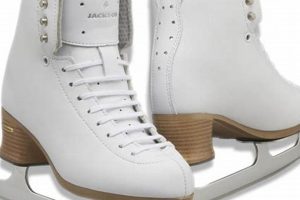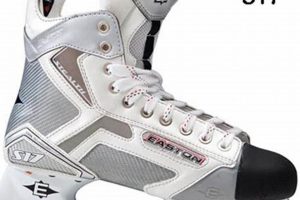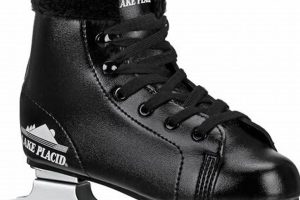Appropriate footwear is essential for individuals starting to learn ice skating. This equipment should prioritize comfort, ankle support, and blade stability. For example, recreational skates often feature softer boots and less aggressive blades, facilitating balance and control for new skaters.
Selecting the correct equipment impacts the learning curve and overall enjoyment of the activity. Proper support helps prevent ankle injuries, and a stable blade builds confidence. Historically, rudimentary designs have evolved into specialized models catering to different skill levels and skating disciplines.
The subsequent discussion details specific features to consider when selecting suitable equipment, various types available, and maintenance best practices to ensure longevity and optimal performance.
Selection and Use Guidance
Selecting appropriate ice skates can significantly improve a novice’s experience. Adhering to the following tips facilitates a smoother and more enjoyable learning process.
Tip 1: Prioritize Fit: Ill-fitting ice skates lead to discomfort and hinder progress. Ensure a snug fit that allows for minimal foot movement within the boot. It is recommended to try on skates with the type of socks typically worn while skating.
Tip 2: Evaluate Ankle Support: Adequate ankle support is essential for maintaining balance and preventing injuries. Look for models with rigid or semi-rigid ankle support, particularly in the initial stages of learning.
Tip 3: Consider Blade Quality: The blade’s material and sharpness impact maneuverability. Stainless steel blades are generally preferred for their durability and resistance to rust. Regular sharpening is necessary to maintain optimal performance.
Tip 4: Opt for Recreational Models: Recreational ice skates are specifically designed for beginners. These models typically offer greater comfort and forgiveness compared to specialized types, such as figure or hockey skates.
Tip 5: Seek Professional Advice: Consulting with a knowledgeable skate shop employee or skating instructor provides personalized recommendations. Professionals can assess foot structure and skill level to determine the most suitable option.
Tip 6: Inspect Lacing System: The lacing system is critical for securing the foot and ankle. Choose a system that allows for consistent and adjustable tightness throughout the boot.
Tip 7: Gradually Increase Usage: New ice skates may require a break-in period. Begin with shorter skating sessions and gradually increase the duration as the boots become more comfortable.
Following these guidelines will aid in selecting ice skates that promote comfort, stability, and confidence, ultimately enhancing the overall skating experience.
The subsequent sections will address common challenges encountered by novice skaters and strategies for overcoming these obstacles.
1. Ankle Support
Adequate ankle support is a fundamental consideration when selecting appropriate ice skates for beginners. Its presence significantly affects stability, control, and injury prevention, all critical for a positive initial skating experience.
- Enhanced Stability
Beginners often lack the lower leg strength and coordination necessary to maintain proper ankle alignment. Stiff ankle support in the skate boot compensates for this deficiency, providing external stabilization. This reduces the likelihood of the ankle rolling inward or outward, which can lead to falls and injuries.
- Improved Control
Ankle support directly influences the skater’s ability to translate intended movements to the blade. With a secure ankle, subtle shifts in weight and pressure can be more effectively transferred, enabling better edge control and turning ability. Without adequate support, these movements become less precise, hindering skill development.
- Reduced Risk of Injury
Ankle sprains are a common injury among novice skaters. Proper ankle support minimizes the risk of such injuries by limiting excessive range of motion and providing a buffer against sudden impacts or awkward landings. The stiffer the boot, the more protection it offers to the ankle joint.
- Facilitates Muscle Development
While firm support is essential initially, it also indirectly aids in the development of the skater’s own ankle and lower leg musculature. By providing a stable platform, the skater can gradually strengthen the supporting muscles without fear of immediate instability or injury, paving the way for progression to less supportive skates as skill improves.
In summary, incorporating sufficient ankle support in ice skates designed for beginners serves as a critical aid in fostering stability, control, and safety. This feature enables new skaters to build confidence and progress their skills without being hampered by a lack of physical strength or an increased risk of injury.
2. Blade Stability
Blade stability, a critical factor in suitable ice skates for novice skaters, directly influences control, balance, and the overall learning experience. A stable blade provides a reliable platform, minimizing unwanted movement and allowing beginners to focus on fundamental skating techniques.
- Enhanced Balance
A secure and rigid blade promotes enhanced balance by reducing lateral movement or twisting. This is crucial for beginners who are still developing their sense of equilibrium on the ice. A stable blade allows for smoother gliding and reduces the likelihood of unexpected falls resulting from blade instability.
- Improved Control
Blade stability allows for better directional control and edge work. With a stable blade, skaters can more accurately translate intended movements into precise turns and stops. The increased responsiveness facilitates skill development and encourages confident maneuvering on the ice.
- Reduced Energy Expenditure
Unstable blades require constant micro-adjustments by the skater to maintain balance. This leads to increased muscle fatigue and wasted energy. A stable blade minimizes these corrections, allowing beginners to skate for longer periods without excessive strain. This reduced fatigue enables longer practice sessions.
- Increased Confidence
A stable blade fosters increased confidence in novice skaters. The reliable platform provided by a secure blade reduces anxiety and promotes a sense of control. This confidence encourages experimentation and allows beginners to push their boundaries and progress more quickly.
The elements of balance, control, reduced energy expenditure, and increased confidence gained from blade stability contribute to a significantly improved learning experience for novice skaters. Prioritizing blade stability when selecting ice skates contributes to a safer, more enjoyable, and more efficient skill acquisition process.
3. Comfortable Fit
A comfortable fit is paramount when selecting appropriate ice skates for those new to the sport. Discomfort can detract from the learning experience, potentially leading to discouragement and hindering skill development. A well-fitted skate enhances the skater’s ability to control their movements and maintain balance.
- Enhanced Learning Environment
A comfortable fit minimizes distractions caused by chafing, pressure points, or excessive movement within the skate. This allows the beginner to focus on learning fundamental techniques, such as proper posture, balance, and basic strides. Without discomfort, the individual can dedicate their attention to skill development rather than managing pain or irritation.
- Improved Circulation and Reduced Fatigue
A skate that is too tight can restrict blood flow, leading to cold feet, numbness, and accelerated fatigue. Conversely, a skate that is too loose can cause excessive rubbing and blistering. A comfortable fit allows for proper circulation, reducing fatigue and enabling longer practice sessions. Extended practice promotes faster skill acquisition.
- Facilitated Proprioception and Control
A snug, but not constricting, fit enhances proprioception, the body’s awareness of its position in space. This improved sense of foot placement within the skate translates to greater control over blade movements. The skater can more effectively translate subtle adjustments in weight and pressure to the ice, leading to improved balance and maneuverability.
- Increased Enjoyment and Adherence
The overall enjoyment of skating is significantly influenced by the comfort of the equipment. Uncomfortable skates can lead to frustration and a reluctance to continue practicing. A comfortable fit fosters a positive association with the activity, increasing the likelihood of continued participation and skill progression.
In summary, a comfortable fit directly impacts a beginner’s ability to learn effectively, maintain endurance, and enjoy the sport of ice skating. Selecting skates that prioritize comfort is crucial for fostering a positive and productive learning environment.
4. Proper Sizing
The selection of ice skates that accommodate the skater’s foot dimensionally is paramount to ensuring both performance and safety. An improperly sized skate, regardless of its construction or intended purpose, presents significant challenges for the novice. The correlation between appropriate sizing and the overall quality of ice skates for beginners is direct: a poor fit negates the benefits of advanced materials or design features.
Ice skates that are too large compromise stability, making controlled movements difficult and increasing the risk of ankle strain or injury. Conversely, skates that are too small restrict circulation, leading to discomfort, cold feet, and potential long-term foot problems. In both scenarios, the skater is unable to develop proper technique, as they are preoccupied with discomfort or instability. For instance, a skater using skates one size too large may struggle with edge control due to excessive foot movement within the boot, hindering their ability to learn basic turns and stops. Similarly, a skater in too-small skates may experience numbness, leading to compromised balance and increased fatigue.
Consequently, ensuring proper sizing is not merely a matter of comfort, but a fundamental aspect of selecting equipment that facilitates effective learning and minimizes the potential for injury. A properly sized skate enables the beginner to focus on technique, develop confidence, and progress safely, thereby enhancing the overall skating experience. The selection process should involve professional fitting assistance to accurately measure foot length and width, accounting for sock thickness, and ensuring adequate toe box space. Therefore, proper sizing is an inextricable component of “good ice skates for beginners,” directly influencing the skater’s ability to learn and enjoy the sport.
5. Recreational Design
Recreational design in ice skates directly addresses the needs and limitations of novice skaters. This design philosophy prioritizes user-friendliness and comfort, fostering a positive introduction to the activity. Specific features tailored to beginners distinguish recreational models from those intended for figure skating or hockey. One critical element is a softer boot construction, providing greater flexibility and allowing for more natural ankle movement. This contrasts with the rigid boots favored by advanced skaters, which can be restrictive and uncomfortable for those still developing their balance and coordination.
The blade design in recreational skates also differs significantly. These models typically feature a less pronounced rocker (the curve of the blade) and a flatter blade profile. This configuration enhances stability, making it easier for beginners to maintain balance and control. Consider, for example, a figure skate’s aggressive rocker, which facilitates intricate turns and jumps. This feature would be detrimental to a beginner, who requires a more stable platform. Furthermore, recreational skates often incorporate enhanced padding and insulation within the boot, ensuring comfort during extended use. This is particularly important for individuals unaccustomed to the feel of ice skates. Many recreational designs prioritize ease of use, incorporating features like quick-drying liners and simplified lacing systems.
In summary, recreational design is an indispensable component of equipment suitable for novice ice skaters. By prioritizing comfort, stability, and user-friendliness, these designs mitigate the challenges associated with learning the sport, fostering a positive experience that encourages continued participation. The deliberate departure from specialized designs, focusing instead on the specific needs of beginners, underscores the importance of recreational design in making ice skating accessible and enjoyable for a wider audience. The selection of ice skates should therefore consider the intent behind the design and its appropriateness for the skater’s skill level.
6. Durable Material
The selection of durable materials directly impacts the longevity and safety of ice skates, particularly for beginners. Skates constructed from robust materials withstand the rigors of initial learning, including frequent falls, impacts with the rink boards, and general wear and tear. The use of high-quality synthetic fabrics, reinforced stitching, and resilient blade mountings mitigates premature degradation, ensuring the skates remain functional and supportive over an extended period. Failure to prioritize durable materials results in equipment that quickly deteriorates, compromising performance and potentially leading to injury. For example, a skate with a flimsy boot construction may provide inadequate ankle support after minimal use, increasing the risk of sprains.
Furthermore, durable materials contribute to the overall value proposition of ice skates. While initial cost may be a factor, skates constructed from robust components offer a longer lifespan, reducing the need for frequent replacements. This is particularly relevant for beginners, who may be hesitant to invest heavily in equipment before committing to the sport. A skate built with durable materials, such as a high-denier nylon exterior or a stainless steel blade, provides a greater return on investment by maintaining its integrity and performance over time. The practical application of this understanding lies in informed purchasing decisions, where durability is weighed alongside other factors such as fit and comfort.
In summary, durable materials constitute a fundamental aspect of ice skates suitable for beginners. Their contribution to longevity, safety, and overall value cannot be overstated. While selecting equipment, prioritizing material quality ensures a sustained and positive skating experience, minimizing the likelihood of equipment failure and facilitating the development of fundamental skills. Recognizing the significance of durable material provides a foundation for making informed choices, ultimately enhancing the beginner’s engagement with ice skating.
7. Lacing System
The lacing system on ice skates directly influences a beginner’s ability to achieve a secure and supportive fit, thereby affecting stability, control, and overall comfort. A well-designed lacing system, incorporating durable eyelets or hooks and a robust lace material, allows for consistent and customizable tightness throughout the boot. This is crucial for novice skaters, who often lack the ankle strength and coordination necessary to maintain proper alignment. The lacing system, in effect, acts as an external support structure, minimizing ankle movement and reducing the risk of injury. For example, a lacing system that allows for differentiated tighteningsnug around the ankle and looser around the toescan provide both support and flexibility, accommodating the individual’s specific needs. A beginner struggling with wobbly ankles may benefit from a lacing system that provides firm ankle support, while another individual may prefer a slightly looser fit around the toes for increased comfort. Therefore, a dependable lacing system is fundamental to what constitutes appropriate equipment for those starting in the activity.
Variations in lacing systems exist, each with advantages and disadvantages for beginners. Speed lacing systems, for instance, may offer convenience but often lack the precision and adjustability of traditional systems. Conversely, traditional lacing systems require more effort but provide a greater degree of control over the fit. The key consideration is the system’s ability to maintain consistent tension and prevent lace slippage during use. Real-world examples highlight the consequences of inadequate lacing systems: beginners using skates with poorly designed laces often experience lace loosening, leading to decreased support and an increased risk of falls. This reinforces the need for a robust lacing system that maintains its integrity throughout a skating session.
Ultimately, the lacing system is an integral component of “good ice skates for beginners,” facilitating a secure, comfortable, and supportive fit. Proper lacing promotes stability, enhances control, and minimizes the risk of injury. While selecting ice skates, evaluating the lacing system’s design, durability, and adjustability is essential. Beginners should prioritize systems that offer consistent tension, prevent slippage, and allow for customizable support, thereby creating a more positive and productive learning environment. The presence of a well-executed lacing system should be a primary consideration when determining the suitability of ice skates for those new to the sport.
Frequently Asked Questions
The following questions address common concerns and misconceptions surrounding the selection and use of appropriate ice skates for individuals new to the sport.
Question 1: Are ice skates sized the same as street shoes?
Ice skate sizing frequently differs from street shoe sizing. Manufacturers utilize varying scales and internal boot construction can affect the required size. Professional fitting is recommended.
Question 2: Is it necessary to sharpen new ice skate blades?
Many new ice skates are not sharpened to a performance level at the factory. It is advisable to have new blades professionally sharpened prior to use. Initial sharpening ensures proper edge alignment for optimal performance.
Question 3: How frequently should ice skates be sharpened?
Sharpening frequency depends on usage and ice conditions. Signs of dull blades include difficulty maintaining edges and a lack of glide. Professional sharpening is typically required after 20-40 hours of use.
Question 4: What type of socks should be worn with ice skates?
Thin, moisture-wicking socks are recommended. Thick socks can restrict circulation and reduce sensitivity, hindering performance. Avoid cotton socks, as they retain moisture and can lead to cold feet.
Question 5: Is it necessary to bake ice skates before use?
Baking, or heat molding, is primarily relevant for higher-end skates with thermo-moldable materials. It is not generally necessary for recreational skates designed for beginners. Consult a professional fitter for guidance on heat molding.
Question 6: How should ice skates be stored after use?
Allow ice skates to air dry completely after each use. Remove the liners (if removable) to facilitate drying. Store the skates in a well-ventilated area to prevent mildew and odor. Blade guards should be used to protect the blades during storage and transport but should not be left on permanently, as they can trap moisture.
Selecting appropriate ice skates for beginners necessitates careful consideration of various factors, including size, blade sharpness, sock selection, and maintenance practices. Adherence to these recommendations enhances the learning experience and promotes safety.
The subsequent section details potential challenges beginners may encounter and strategies for effective problem-solving.
Conclusion
The preceding discussion has examined critical elements in selecting appropriate ice skates for beginners. Ankle support, blade stability, comfort, proper sizing, recreational design, material durability, and lacing systems were each highlighted as integral features for equipment designed to facilitate skill development and minimize the risk of injury. Adherence to these considerations establishes a foundation for a positive and productive learning environment.
Ultimately, informed decision-making regarding equipment selection contributes to enhanced safety, improved performance, and increased enjoyment of the sport. Prioritizing these factors equips new skaters with the tools necessary to progress confidently, transforming a potentially challenging endeavor into a rewarding and fulfilling experience.







